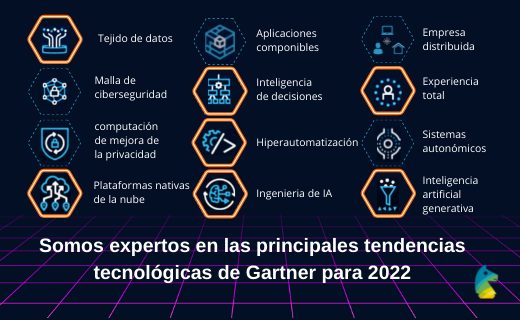
23 Jan Gartner’s Top Strategic Technology Trends for 2022
Once again, Gartner identifies the essential technology trends for digital business, and at Habber Tec, we present a summary of the list, which consists of 12 strategic technology trends that will help companies not only stand out from their competitors but also achieve efficiency and accelerated growth. Furthermore, as noted in the Gartner report, these trends “transform Chief Innovation Officers (CIOs) and IT executives into strategic partners of the business.”
Data Fabric
The aim of data fabric is to simplify the complexity of data by automating the integration, governance, and processing of data across different platforms and business users, making it available from anywhere it’s needed, regardless of where it is hosted.
Data fabric can use analytics to actively know and recommend where data should be used and changed. It can reduce data management efforts by up to 70%.
Cybersecurity Mesh
The cybersecurity mesh is a composable and flexible architecture that integrates distributed and disparate security services. It also enables the best independent security solutions to be used together for greater global protection, with control points placed closer to the assets they need to protect. It can quickly and reliably verify identity, context, and policy compliance across all types of environments, whether cloud-based or not.
Privacy-Enhancing Computation
Privacy-enhancing computation uses various protection techniques that allow value to be extracted from data while simultaneously meeting regulatory requirements. It also ensures the processing of personal data in environments that are not secure enough (which is becoming increasingly important due to regulatory changes around privacy and data protection, and growing consumer concerns).
Cloud-Native Platforms
Cloud-native platforms are technologies that enable the creation of new, resilient, elastic, and agile application architectures to keep pace with the fast-moving digital development.
Cloud-native platforms improve upon the traditional “lift-and-shift” approach (or relocation), which doesn’t leverage all the benefits of the cloud and adds complexity to maintenance.
At Habber Tec, we adapt to the needs of our clients by offering various types of cloud (hybrid, public, private).
Composable Applications
Composable applications facilitate the use and reuse of code, speeding up the time to market for new software solutions and releasing business value.
Composable applications are built from modular, business-centric components.
Decision Intelligence
Decision intelligence is a practical approach that improves decision-making within an organisation. Each decision is modelled as a set of processes, using knowledge and analysis to shape decisions, learn from them, and refine them.
At Habber, we employ decision intelligence, based on technologies such as machine learning, deep learning, natural language, and Operational Decision Management.
Hyperautomation
Hyperautomation is a revolution born from the convergence of advanced technologies like artificial intelligence and robotics to automate processes and augment human capabilities. Hyperautomation enables scaling, remote operations, and radical transformation of the business model.
At Habber Tec, we are experts in hyperautomation, using various technologies from IBM’s Cloud Pak for Business Automation platform to help our clients address the main challenges organisations face this decade, such as managing volatile demands or transforming business models for the new digital context.
AI Engineering
AI engineering automates data, model, and application updates for delivery. Combined with solid AI governance, AI engineering makes AI delivery operational to ensure its continued commercial value.
Distributed Enterprises
Distributed enterprises reflect a business model prioritising digital and remote approaches to improve employee experiences, digitalise consumer and partner touchpoints, and develop product experiences. This type of company can better meet the needs of remote employees and consumers, driving the demand for virtual services and hybrid workspaces.
Total Experience
Total experience is a business strategy that integrates employee experience, customer experience, user experience, and multiexperience across multiple touchpoints to accelerate growth.
Total experience can increase trust, satisfaction, loyalty, and advocacy from both customers and employees through holistic management of stakeholder experiences.
Autonomic Systems
Autonomic systems, which can be managed physically or via software, are capable of learning from their environment and dynamically modifying their own algorithms in real time to optimise their behaviour in complex ecosystems.
Autonomic systems create an agile set of technological capabilities that can help in new requirements and situations, optimise performance, and defend against attacks without human intervention.
Generative AI
Generative AI uses data to learn what artefacts are and generate new, innovative creations that are similar to the original but not a repetition of it.
Generative AI has the potential to produce new forms of creative content, such as videos, and accelerate R&D cycles in areas ranging from medicine to product design.
The most important thing is not to try to apply all these trends in our business, but to determine which one(s) our organisation needs to achieve the goals we desire. For all of this, we can advise you at Habber Tec, with an initial Design Thinking meeting. If you’re interested, click here, and we’ll get in touch as soon as possible.



